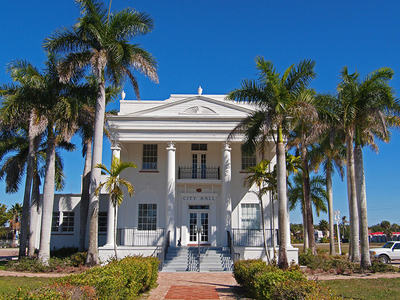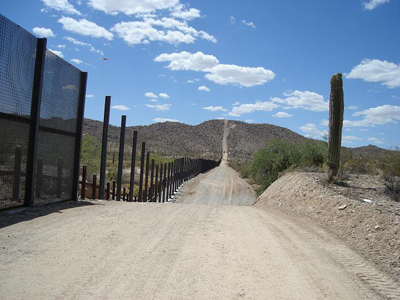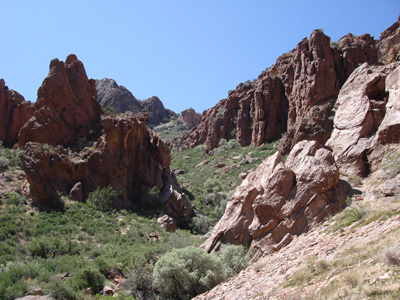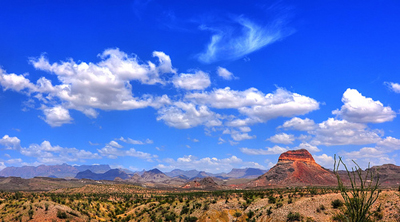
Remoteness creates smuggling opportunity
America’s national parks offer vast wildernesses intended to be enjoyed for their scenery and wildlife. Unfortunately, many criminals see the remote areas of national parks as perfect venues for smuggling.
Everglades City, a tiny town on the Southwest coast of Florida and near Everglades National Park, has gained notoriety for its history of illegal activity. During prohibition, local residents became rumrunners to make ends meet. A few decades later, locals poached plumes from pink spoonbills and white egrets for women’s hats.
 |
Everglades City City Hall today. It is just minutes from the West Coast Visitor Center of Everglades National Park (Photo courtesy of John Picken). |
In the 1980s local shrimpers, crabbers and fisherman who knew the maze-like waters of the area turned from their usual catch to “square grouper”… bales of marijuana- when they realized how much money they could make.
“It’s the money, that big, fast, easy money, that’s attracting them,” said Mayor Askren of Everglades City in a New York Times article at the height of the crime wave in 1982. “It’s beyond our control. It’s so obvious what’s going on here, and it upsets me.”
In July 1983, more than 200 local, state and federal agents led one of the nation’s biggest marijuana smuggling raids in Everglades City and surrounding Collier County. They blocked Florida 29, the only road in and out of town and boarded every boat docked in the bay.
Agents seized 14 fishing boats, two small planes, arsenals of weapons, 500,000 pounds of marijuana and $5 million in assets. Two hundred people were arrested, including David McCain, a former Florida Supreme Court justice.
“I’m not proud of hauling marijuana,” said Totch Brown, one of Everglades City’s most well known smugglers, in a Los Angeles Times article. “But when the pompano fishing went down, mullet prices fell, and someone tells you that you can make $10,000 for an hour’s work, the average man would have done the same thing.”
Assistant U.S. Attorney Russell Stoddard took a different view in the same Los Angeles Times article.
“They have romanticized and rationalized their past to make it almost folk culture. In fact, they were responsible for bringing an enormous amount of marijuana into the United States. Fathers testified against sons, wives against husbands. People were destroyed by this. People were killed. There was nothing romantic or pretty about it.”
 |
Border fence under construction at Organ Pipe Cactus National Monument (Photo courtesy of the National Park Service). |
These days, Everglades City has returned to focusing on fishing and tourism. Its most prominent annual event is an annual seafood festival. Locals say they have learned that smuggling is just not worth it.
Smuggling in Everglades National Park may have declined, but it is increasing dramatically in national parks along the United States’ border with Mexico. In addition to drugs, illegal immigrants are being smuggled across the border.
In 1994, the U.S. Attorney General authorized a new border enforcement strategy based on “prevention through deterrence.” Millions of dollars went to border control in San Diego, El Paso and Nogales. Illegal immigrants turned to the wildernesses of Organ Pipe, Cabeza National Wildlife Refuge, and Big Bend National park to make their border crossings.
Organ Pipe Cactus National Monument has become the epicenter of illegal border crossings in national parks. According to an article on Organ Pipe Cactus in Backpacker Magazine, the 350,000 acre park used to get only 100 hikers a month. Now an estimated 300,000 people enter the park every year, with only one percent permit-bearing backpackers.
The article also detailed how Border Patrol apprehensions from the agency’s station just north of Organ Pipe Cactus increased thirty times over from 1994 to 2001. More than one hundred people cross Sweetwater Pass, what used to be a remote hiking trail, every day.
“We’ve counted one thousand people crossing in a night,” said Organ Pipe Cactus law enforcement ranger Bo Stone in the Backpacker Magazine article. “They’re all walking single file, with a water jug in one hand and their bag of belongings in the other.”
 |
The rugged terrain of Organ Pipe Cactus National Monument that many smugglers cross (Photo courtesy of Joshua Boles). |
Sue Walters, the public information officer for Organ Pipe Cactus National Monument, is frustrated by the negative attention the park has received in the media.
“Yes, we do have human trafficking and smuggling in the park. We have worked closely with Border Patrol to curtail the activity and keep our visitors safe,” she said. “But the press over exaggerates the danger and doesn’t write about anything positive we do.”
“We took visitors on a tour to a closed off area of the park to see a historic site, and instead of writing about what a great thing the rangers are doing, the press makes a huge deal out of the fact that the tour had an armed escort.”
“The negative media attention significantly brings down the number of visitors to the park. We can’t lose the name as the most dangerous park in America,” said Walters.
Walters said the migrants also cause serious environmental impacts in the park. They leave so much trash that the rangers have given up trying to collect it.
David Elkowitz, public information officer for Big Bend National Park, acknowledges encountering similar smuggling problems in Big Bend.
“Yes, there is some historic smuggling that does and has gone on in the park. There is also a much greater degree of enforcement, law enforcement officers and Border Patrol in this area,” said Elkowitz.
“Relatively compared to other parks on the border, smuggling remains much lower (in Big Bend) than in any other part of the 2,000 mile border,” Elkowitz stated.
In addition to illegal immigrants, smugglers are also bringing drugs across the border. According to the Backpacker Magazine article, in 2003, Stone confiscated 14,000 pounds of Mexican marijuana in Organ Pipe Cactus. He estimates that it is probably only one percent of the drugs moving through the national monument.
In 2002, Park Ranger Kris Eggle was shot in Organ Pipe Cactus when he responded to a call from Mexican authorities saying drug dealers had crossed into the park. Eggle was the first one on the scene, and was fatally shot by one of the drug dealers who fired on him with an AK-47.
It is not just law enforcement who suffer casualties. More people die in Organ Pipe than anywhere else along the border, due to summer temperatures that reach 120 degrees Fahrenheit and few sources of water.
| The vast spaces of Big Bend National Park in West Texas (Photo courtesy of R. Hensley). |  |
Stone told Backpacker Magazine he believes an expanded work visa program is worth exploring. He says about 95 percent of the migrants caught are simple laborers trying to work in the United States.
“The Border Patrol is out there chasing the same guy day after day. We need to let the people who are coming in to pick oranges go through our ports legally so we can address more important concerns like drug smuggling and terrorism,” Stone stated.
While the vast, uninhabited wildernesses of the United States’ national parks are one of their main appeals, the surge of smugglers in these areas is damaging the natural environment and causing casualties on both sides of the law.

Comments are Closed